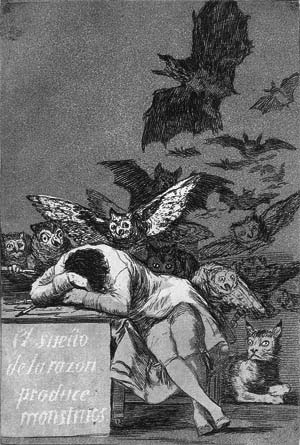Two exhibitions
dal 1/6/2005 al 24/9/2005
Segnalato da
Conrad Atkinson
Saint Clair Cemin
Madeleine Hatz
Yun-Fei Ji
Fabian Marcaccio
Yasumasa Morimura
Rona Pondick
Carlos de los Rios
Ray Smith
Masami Teraok
Kimiko Yoshida
Elga Wimmer
1/6/2005
Two exhibitions
Chelsea Art Museum, New York
'Los Caprichos'. Francisco de Goya's etching and aquatint series (published in 1799) is a view of both man's power of spiritual creation and the failings of his own nature. And it is this insight into the reality of man which makes it possible to depict the human figure as beautiful and at the same time to caricature it. Such a composition of socio/political satire was enlightening to the 18th-century rationalist, so confident about his ability to comprehend both man's capabilities and limitations. The artists in 'Here Comes the Bogey-Man' pay tribute to Goya and carry his spirit, evoking global issues, into the 21st century.

Los Caprichos and Here comes the Bogey-Man
Curated by Elga Wimmer
Francisco de Goya’s etching and aquatint series “Los Caprichosâ€
(published in 1799) is a view of both man’s power of spiritual creation
and the failings of his own nature. And it is this insight into the
reality of man which makes it possible for Goya to depict the human
figure as beautiful and at the same time to caricature it. Such a
composition of socio/political satire, no doubt, was enlightening to
the eighteenth-century rationalist, so confident about his ability to
comprehend both man’s capabilities and limitations. Goya wanted to
express, not represent. The plate by Goya entitled “The Sleep of Reason
produces Monsters†(first intended as title for the whole series of
“Los Caprichosâ€) reads: “Imagination, deserted by reason, begets
impossible monsters. United with reason, she is the mother of all arts,
and the source of their wonders.†(“Goya’s Caprichos†by José Lopez-Rey
- Beauty, Reason & Caricature Vol.1, 1953 Princeton University Press).
In “Here Comes the Bogey-Man†(“Que viene el Cocoâ€) Goya refers to the
“Black Man†that children fear more than their own father as a symbol
of the blind belief in authority ruling the naive and influenceable
commoner. Needless to say, we have quite a few of those “black and
fearful ghosts†in our culture, ever-present to create panic and fear –
the consequence as in Goya’s time of superstition and poor education.
In an essay for the exhibition “Drawings by Goya†at the Prado in 1947,
Andre Malraux wrote: “Goya discovers his genius the day that he dares
to stop to please. He substitutes seduction with revelation and
discovers the vulnerability of the spectator, the weakness of a culture
put in question face to face with the artist that proclaims his truth.
Goya created a desperate and solitary art – the beginning of modern
painting.â€
The artists in “Here Comes the Bogey-Man†pay tribute to Goya and carry
his spirit, evoking global issues, into the 21st century: In direct
appropriation from “Los Caprichos†by Yasumasa Morimura and Conrad
Atkinson. In a mythological way, in the work of Rona Pondick, Ray Smith
and Kimiko Yoshida. In socio/political satire with Saint Clair Cemin,
Carlos de los Rios and
Yun-Fei Ji. In symbolic picturings of the “dark side†by Madeleine Hatz
and Fabian Marcaccio (Goya said “there is only black and white in
nature.â€) In a pun on religious issues by Masami Teraoka.
There was rarely a time more appropriate to rethink the relationship of
the artist and his society than Goya’s era and our own. The novelist
Emilia Pardo Bazan wrote in 1906 in an article published in La Lectura:
“The history of Goya’s thought and the progressive development of
moral, social, philosophical and political ideas in his work is
probably more interesting than his novelistic life.†In the work of
Rona Pondick and Kimiko Yoshida there is an expressive, abnormal and
violent ugliness like that in “Los Caprichosâ€: Romantic Ugliness. As in
Goya’s time, our daily news reports monstrosity, insanity, brutality,
violent madness, perversity, and torture, all influencing and coloring
the work of the artists in “Here Comes the Bogey-Man.†Only momentarily
do we find a ray of hope in Goya’s “Los Caprichos†as well as in the
work of these contemporary artists: and it is a dawn of intellectual
and emotional hope.
The Gabarron Foundation is supporting this exhibition, creating
awareness of the importance of art, culture and science in the world of
today.
With the support of the Cultural Department of the Consulate General
of Spain in New York. With the support of Instituto Cervantes in New
York.
Opening reception June 2, 6 – 8pm
Press preview June 2, 4 – 6pm
Chelsea Art Museum
556 West 22nd Street - New York



